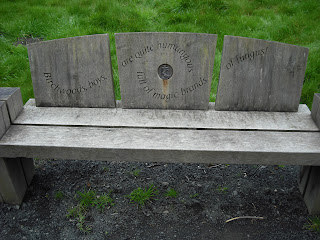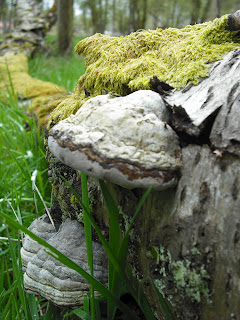Earlier in the year a friend and I went for a wander around Loch Leven, near Kinross. I was looking back over the photos today and it reminded me of how refreshing some of the woodland was. Walking from the RSPB reserve (Vane Farm) anti-clockwise around the loch, we passed veteran oak trees into a more closely-packed birch-dominated woodland with wet areas of willow and alder, and some Scots pine (presumably an old plantation?) thrown in.
There was a lovely sense of untidyness prevailing here - log piles, standing and fallen deadwood everywhere, and natural-feeling paths. The veteran oaks were stag-headed, had hollow cavities and were generally scruffy looking - and all the better for it. Tinder fungus (Fomes fomentarius) and birch polypore (Piptoporus betulinus) were everywhere, with birch trees in various stages of collapse because of them, and all the trees and logs were covered in a variety of mosses and lichens.
The only curiosity was a distinct lack of young trees and an understorey. Could this be from deer or sheep grazing? Certainly the fences could have done with some TLC. Or could it be that this woodland is in fact a neglected plantation, thus accounting for some of the lack of the variety of tree ages? Perhaps the pine plantation spread further throughout the woods, and the birch is a secondary woodland arising from the felling of part of it? It would be interesting to go back now the growing season is well under way and try to make sense of what the flower communities are telling us about the woodland's history.
About Me

- Treecological
- Cumbria, United Kingdom
- A forester, naturalist and environmentalist.
Sunday, 29 July 2012
Sunday, 22 July 2012
Phototropism
Friday, 20 July 2012
Spalted birch
By pure chance I sawed up an old rotting ring of birch trunk to put it through the chipper at work. Inside on the freshly-cut surfaces was a beautiful spalting pattern - I've seen it on beech before, and even have a lovely spalted-beech bowl turned by my partner's papa, but never seen it on birch before. There was honey fungus bootlaces all over it, but perhaps other fungi have been attacking it too? Either way, the battle between fungus (fungi?) and tree have been beautifully documented, with the tree laying down its defence system by biochemically altering the wood, and the fungus eventually overcoming it and forcing the tree to draw new battleground lines. OK, a slightly anthropological view, but that's roughly what has happened.
Subscribe to:
Comments (Atom)









